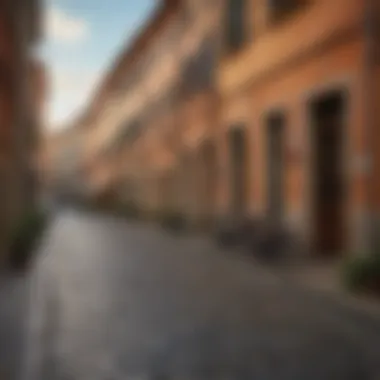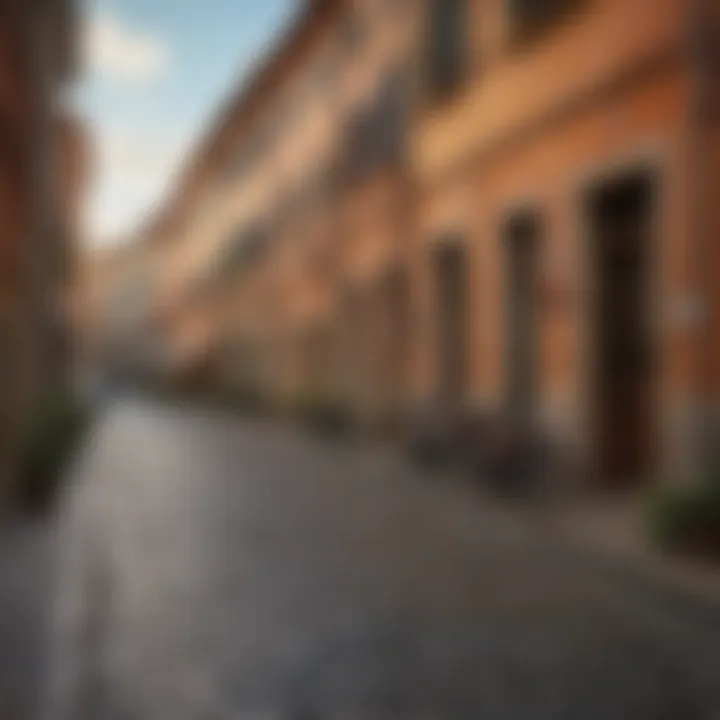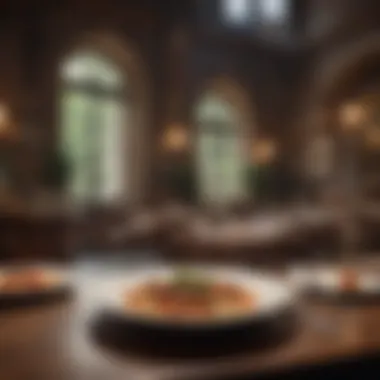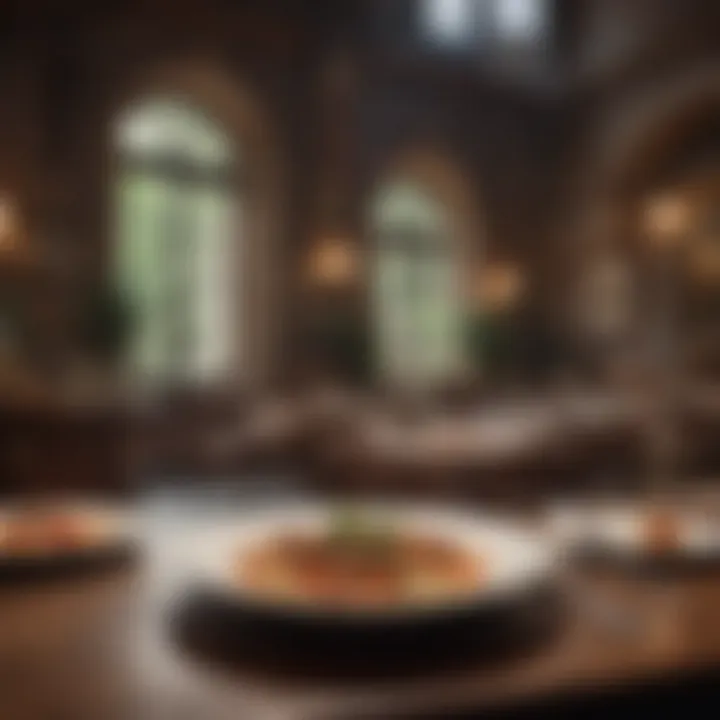Exploring Rome: A Pragmatic Guide to the Eternal City


Intro
Rome is a city steeped in history, a mosaic of ancient ruins and modern vibrancy. It is not just a destination; it is an experience that transcends time. As you wander its cobblestone streets, you will encounter the echoes of emperors, artists, and everyday life from centuries past. This guide aims to provide both cultural insight and practical advice to help you navigate the Eternal City with ease.
From the majestic Colosseum to the serene beauty of the Vatican, Rome presents visitors with a wealth of landmarks and hidden gems. Understanding these sites’ historical significance will enhance your appreciation of their grandeur. Additionally, familiarizing yourself with local customs and dining etiquette will enrich your interactions with the rich culture of Rome.
Below, we will explore essential tips to make your visit both informative and enjoyable.
Preface to Rome
Rome is not just a city; it is a timeline of history. The significance of this section lies in laying the foundation for understanding what makes Rome worthy of exploration. Each cobblestone street, monumental architecture, and historic ruin is a testimony to civilizations that have shaped Western thought and culture. When one contemplates travel to Rome, considering its past and its ongoing cultural relevance can greatly enhance the experience. Visitors have opportunities not only to see the beauty but to appreciate the layers of meaning behind what they encounter.
Historical Context
Understanding the historical context of Rome provides crucial insights into its development. Founded in 753 BC, Rome served as the capital of the Roman Kingdom, Republic, and Empire. Each period contributed to the rich tapestry of the city. The transition from the Republic to Empire brought architectural marvels such as the Pantheon and the Colosseum. The fall of the Western Roman Empire in AD 476 marked the beginning of a different era. This was the Dark Ages, during which Rome faced decline, but it also set the stage for the Renaissance in the 14th century, reviving art and philosophy.
Visitors can see artifacts from these distinct phases scattered throughout the city. Museums like the Capitoline Museums and the Vatican Museums house ancient sculptures and Renaissance masterpieces. These historical layers enrich the journey, turning a simple visit into an educational adventure.
Cultural Significance
Rome’s cultural significance is immense, echoing throughout literature, art, and politics. The Eternal City is often viewed as the birthplace of urban civilization and has influenced countless cultures worldwide. The Vatican, home to the Pope, serves as a spiritual center for millions, amplifying Rome's impact beyond geography.
Roman cuisine, grounded in simplicity and flavor, is another reflection of the city’s culture. Traditional dishes like [Cacio e Pepe] and [Carbonara] have become staples across gastronomic circles. Dining in Rome is not only about food; it is about tradition, family, and social interaction.
When exploring Rome, one engages with centuries of evolution in art and architecture—from ancient ruins to baroque churches. Art festivals throughout the year celebrate local craftsmanship, inviting visitors to participate in Rome’s vibrant artistic scene. Understanding these cultural elements allows for a more immersive experience, making it clear why Rome continues to captivate those who wander its streets.
"Rome is the city of echoes, the city of illusions, and the city of yearning." — Giovanni Pascoli
By investigating these layers of history and culture, one lays the groundwork for what should be a thoughtful journey through the city. The more one appreciates Rome's past and present, the richer the experience will be.
Planning Your Trip
Planning your trip to Rome is a necessary step if you want to make the most of this ancient city. With its rich history, vibrant culture, and iconic landmarks, Rome provides truly unique experiences. Effective planning can help ensure that you do not miss any highlights or important cultural aspects. Furthermore, understanding logistical elements such as time of year and entry requirements contributes significantly to smooth travel.
Best Time to Visit
Understanding the best time to visit Rome can greatly enhance your experience. The city has a Mediterranean climate, meaning the summers can be quite hot and crowded. Late spring and early autumn are particularly pleasant due to milder weather and fewer tourists. Many travelers appreciate visiting during this period for lower prices on accommodations and better access to attractions.
Here’s a breakdown of the seasons:
- Spring (March to May): This season witnesses blooming flowers and a warmer climate. Ideal for outdoor sites like the Vatican Gardens.
- Summer (June to August): While it is a popular time due to school holidays, it might be uncomfortably hot. Explore early in the morning or later in the evening to avoid heat.
- Autumn (September to November): Offers comfortable weather and a vibrant atmosphere as the leaves change. Many festivals take place during this time.
- Winter (December to February): While it may be chilly, the city is less crowded. This is perfect for those wanting a quieter visit and an opportunity to experience Christmas markets.
Visa and Travel Requirements
Travelers must also consider visa and travel requirements before embarking on their journey to Rome. Many European travelers can enter Italy without a visa for short stays. However, travelers from other countries may need to secure a Schengen visa.
Here are some helpful guidelines:
- Check your passport validity: Ensure your passport is valid for at least three months beyond your planned departure date.
- Schengen Visa: If you require a visa, apply at the Italian consulate or embassy in your home country. Requirements can vary.
- Travel Insurance: Consider purchasing travel insurance. It can provide peace of mind regarding health issues or trip cancellations.
"Careful planning regarding visas and travel requirements can shape a memorable trip to Rome."
In summary, proper planning enhances the experience of visiting Rome significantly. Recognizing the best time to visit and understanding visa requirements sets the stage for a successful journey into the heart of Italy.
Accommodations in Rome
Choosing the right accommodation in Rome significantly enhances the overall visitor experience. Options vary from luxurious hotels to local bed and breakfasts, each offering distinct advantages. Travelers need to consider their priorities, such as location, price, and comfort. In a city steeped in history and culture, the place you stay can be a window into the local lifestyle or a tranquil retreat after a long day of exploration.
Types of Accommodations
Rome offers diverse types of accommodation to suit different preferences and budgets:


- Hotels: Ranging from five-star luxury to quaint boutiques, hotels in Rome provide convenience and comfort. For high-end experiences, chains like The Hassler or Hotel de Russie offer exceptional amenities and service. More affordable options can be found in the Trastevere area, which combines charm with accessibility.
- Hostels: For budget-conscious travelers, hostels provide a social atmosphere. Places like Generator Rome offer a mix of shared and private rooms, catering to young travelers and backpackers.
- Vacation Rentals: Platforms like Airbnb and Vrbo allow visitors to rent apartments. This option gives the feeling of living like a local while enjoying a few home comforts, such as cooking in a kitchen.
- Bed and Breakfasts: For a more personalized experience, B&Bs offer warmth and hospitality. Areas around Campo de' Fiori and the Spanish Steps host several options.
- Boutique Accommodations: Unique due to their character and style, boutique hotels often provide an intimate atmosphere. Locations in neighborhoods like Monti or Testaccio can be charming choices.
Recommended Neighborhoods
Selecting the right neighborhood is just as crucial as choosing the type of accommodation. Each area in Rome has its own charm and character. Here are a few recommended neighborhoods to consider:
- Trastevere: Known for its vibrant nightlife and authentic dining scene, Trastevere is ideal for those looking to experience local culture. Narrow cobblestone streets and the presence of traditional trattorias create a unique ambiance.
- Centro Storico: Staying in Centro Storico keeps you close to iconic sights like the Pantheon and Piazza Navona. This area is bustling with tourists but offers plenty of historical charm.
- Testaccio: A less touristy alternative, Testaccio is known for its food market and authentic Roman cuisine. It is a great choice for food lovers wishing to explore traditional dishes.
- Monti: Located near the Coliseum, Monti is trendy and artistic. Visitors can find cool shops, quaint cafes, and a mix of residential life that adds character to your stay.
Rome’s neighborhoods are the threads that weave its rich tapestry, offering distinct experiences for every traveler.
In summary, understanding the variety of accommodations and choosing the right neighborhood ensures a fulfilling stay in Rome. Each choice influences not just comfort, but the overall experience of engaging with the city's history and culture.
Transportation in Rome
Transportation plays a crucial role in enhancing the overall visitor experience in Rome. The City is vast, with layers of history and culture interwoven through its streets. Understanding how to navigate through this bustling metropolis is essential for anyone wanting to fully appreciate its offerings. From efficient public transport to leisurely walking routes, this section aims to provide insights into the various means of getting around Rome.
Public Transport Overview
Rome boasts a diverse public transport network, encompassing buses, trams, and the metro system. These options present notable advantages, particularly for those looking to explore efficiently.
- Metro: The metro system consists of three main lines—A, B, and C. Each line connects key areas of interest, including major attractions such as the Vatican, the Colosseum, and Termini Station. Though not as extensive as networks in other cities, it is reliable and often the quickest option for traversing longer distances.
- Buses and Trams: The bus network is extensive and covers areas beyond the metro's reach. Buses run frequently, making them convenient for reaching specific neighborhoods and less touristy spots. Trams complement the service by connecting various districts.
- Tickets and Fares: It is advisable to purchase tickets in advance, which can be done at vending machines or newsstands. A standard ticket allows for 100 minutes of travel across all modes of public transportation, which is cost-effective and convenient.
Understanding the routes and schedules provides a practical foundation for moving around the city without unnecessary delays.
Walking vs. Using Transport
Walking through Rome offers a unique way to experience its charm. The city is known for its picturesque streets and hidden treasures, which can only be fully appreciated on foot. Here are some considerations for both options:
- Walking:
- Using Transport:
- Allows for spontaneous exploration. Visitors can admire architecture, shop, and even stop at small cafes that may not be near transport routes.
- The compact nature of many significant sites means that walking can be faster than waiting for transport.
- Walking fosters a more intimate connection with the environment.
- Ideal for covering larger distances, especially on hot days or when time is limited.
- Public transport can help avoid fatigue, making it a better choice for those who may struggle with walking long distances.
- Transfers and connections can be made easily with well-timed public transport routes.
Ultimately, mixing both options creates a more enriching experience. Walking can complement rides on public transport, allowing travelers to enjoy both efficiency and leisure.
"The true essence of Rome unfolds not just through sights, but through the journey itself."
Understanding the transportation ecosystem in Rome is essential for any traveler. With careful planning, it’ll be possible to soak up the city's elegance and allure, turning every corner into a potential adventure.
Major Attractions
The main attractions of Rome do not merely serve as points of interest; they represent the heart and soul of the city. Understanding these sites helps grasp the essence of Rome's history and culture. Whether one is wandering through ancient ruins or contemplating magnificent artworks, these attractions reveal the layers of time that have shaped this eternal city. Visitors gain not just the experience of seeing extraordinary structures but also connection to the narratives interwoven into the fabric of Roman life. Therefore, exploring these major attractions is crucial for any traveler seeking depth in their visit.
The Colosseum
The Colosseum is perhaps the most recognizable symbol of Rome. As the largest amphitheater ever built, it showcases the grandeur of ancient Roman engineering. Constructed around 70-80 AD, this structure could host tens of thousands of spectators. Its design reflects both architectural innovation and the social dynamics of its era. Visitors can step inside and imagine the grand spectacles that once captivated audiences, such as gladiatorial contests and public events.
Key Facts about The Colosseum:
- Size: It is approximately 189 meters long and 156 meters wide.
- Capacity: Built to accommodate around 50,000 to 80,000 spectators.
- Significance: A UNESCO World Heritage Site, it underscores Rome's historical importance.
While the structure endures wear from the ages, its resilient spirit continues to inspire awe. Visiting the Colosseum is essential not only to marvel at its architecture but also to reflect on the stories of those who once entered it.
The Vatican City
The Vatican City holds immense spiritual significance as the center of the Roman Catholic Church. This independent city-state, encircled by Rome, is home to the Pope and a treasure trove of art and history. The Vatican Museums, including the Sistine Chapel, attract millions of visitors each year, with Michelangelo's ceiling being a pinnacle of Renaissance art.
Why The Vatican City Matters:
- Cultural Wealth: The collection features artworks from multiple artists over centuries.
- Religious Importance: It is a pilgrimage site for millions worldwide.
- Political Significance: The Vatican’s role influences global Catholicism.


Spending time in Vatican City offers an opportunity for quiet reflection amid the vibrancy of art and faith. It invites visitors to appreciate not just the artwork, but also the deep-rooted traditions behind it, making it a critical aspect of any Roman journey.
The Roman Forum
The Roman Forum provides a glimpse into the heart of ancient Roman public life. Once a bustling hub of politics, religion, and commerce, it remains one of the most significant archaeological sites in the world. Walking through the Forum allows one to envision the discussions that shaped empires and the rituals that bound citizens together.
Elements to Explore in The Roman Forum:
- Architectural Highlights: Temples, basilicas, and arches demonstrate Roman architectural mastery.
- Historic Events: It was the site of various public speeches and criminal trials.
- Cultural Identity: The Forum reflects the social and political life of ancient Rome.
Exploring the Roman Forum is more than a mere activity; it is an immersion into the civic life that once flourished here. This space is crucial for comprehending the development of law, politics, and society, which continue to resonate into modern times.
"The beauty of a place like Rome lies in its ability to transport one through history, revealing past lives amid contemporary ones."
The Colosseum, Vatican City, and the Roman Forum are not just attractions; they embody the stories and ideals of a civilization. Each location offers unique insights, making them indispensable parts of the Roman experience.
Culinary Scene
The culinary scene in Rome is not just about eating; it represents a connection to history, culture, and tradition. Roman cuisine is deeply tied to the city's identity, showcasing local ingredients and recipes passed down through generations. Understanding this aspect enriches the travel experience, allowing visitors to gain insight into Rome’s lifestyle beyond the typical landmarks.
Traditional Roman Dishes
Roman dishes are a testament to the city’s rich agricultural heritage. Some classic favorites include:
- Cacio e Pepe: This simple yet flavorful pasta dish features pecorino romano cheese and black pepper. The creaminess formed from melted cheese combined with pasta water is exemplary of Roman skill with basic ingredients.
- Carbonara: Made with eggs, guanciale (cured pork cheek), pecorino cheese, and black pepper, this dish highlights the Roman penchant for rich flavors and textures.
- Saltimbocca alla Romana: This dish consists of thin slices of veal topped with prosciutto and sage, cooked in white wine. It is a representation of Roman fine dining.
These dishes typically utilize minimal ingredients, reflecting the locals’ creativity in transforming them into delightful meals. Besides providing depth in flavor, they suggest a historical background focused on resourcefulness in the kitchen.
Dining Etiquette
Dining in Rome carries specific customs that visitors ought to understand for a smoother experience:
- Reservations: Making reservations is often necessary, especially in popular trattorias due to high demand.
- Timing: Lunch usually occurs between 1:00 PM and 3:00 PM, while dinner is served later, often starting at 8:00 PM. It is advisable to adapt to these times.
- Personal Interaction: Engaging in a polite conversation with staff is appreciated. A simple salutation like "Buongiorno" at lunch or "Buonasera" in the evening sets a warm tone.
Rome’s dining experience transcends beyond just the food. It is about understanding the spirit of Italian hospitality, which values warmth and joy during meals.
"To eat is a necessity, but to eat intelligently is an art."
Embracing the culinary scene not only fills the stomach but also feeds the soul. This connection to local customs enhances cultural immersion in this timeless city.
Understanding Local Customs
In any city, understanding local customs is crucial. Rome, with its rich tapestry of history and culture, has unique social norms and practices. Knowing these can enhance interactions with locals, provide a more immersive experience, and serve as a sign of respect towards the culture you are engaging with. This section provides a closer look at social norms and the vibrant festivals that punctuate Roman life.
Social Norms
Every society has its unwritten rules. In Rome, addressing individuals respectfully is essential. For instance, using titles like "Signore" or "Signora" can set a positive tone in conversations. Maintaining eye contact demonstrates sincerity, reflecting the local value placed on direct communication. Casual conversations may appear friendly, but locals appreciate a sense of formality, especially when first meeting someone.
Additionally, personal space tends to be less pronounced in Italy. Expect closer physical proximity during discussions, particularly in crowded areas. This can initially feel overwhelming for some visitors.
Key Point: Respecting local customs around greetings and conversations fosters goodwill and opens doors to richer exchanges.
When dining, wait to be seated rather than choosing a table yourself. Understanding meal times is also important; lunch is typically served from 1 PM to 3 PM, while dinner often starts late, around 8 PM or 9 PM. Tipping is generally appreciated, but rounding up is often sufficient, unlike in some other cultures where larger gratuities are standard.
Festivals and Events
Roman festivals provide insights into the city's traditions and lifestyle. These events can reflect historical commemorations, religious observances, or simply community celebrations. Participating in these festivals is an excellent way to connect with locals and experience firsthand the joy and enthusiasm that characterize Roman culture.
One notable festival is the Carnival of Rome, which precedes Lent. This colorful event features parades, masquerade balls, and stunning costumes. Another significant celebration is the Feast of the Immaculate Conception on December 8th, with its grand ceremonies and religious processions.
- Plan to witness the Estate Romana held every summer, showcasing outdoor cinema, concerts, and art exhibitions across the city.
- Be aware of major local holidays like Natale (Christmas) and Pasqua (Easter), both of which involve various traditions and gatherings.


Learning about these festivals offers an excellent opportunity for cultural immersion, capturing the joy and vibrancy of Roman life.
In summary, grasping local customs—including manners and festival participation—adds depth to one's experience in Rome. Understanding these social intricacies not only fosters appreciation but also enriches the journey, allowing travelers to engage with the city authentically.
Safety Considerations
When visiting Rome, safety is an essential topic that should not be overlooked. Understanding how to navigate the city safely can enhance your experience, ensuring you focus on the beauty and culture of this historic locale, rather than on potential worries. By familiarizing yourself with various safety tips and being aware of your surroundings, you can significantly reduce risks. This section goes over fundamental safety measures that any traveler, particularly women, should consider when exploring Rome.
General Safety Tips
- Stay Aware of Your Surroundings
Always be conscious of what is happening around you. This includes being mindful of crowds or any individuals who seem overly aggressive or suspicious. Enjoying the sights is important, but don’t let your guard down. - Keep Valuables Secure
Use a money belt or anti-theft bag to keep your items safe. Avoid placing your wallet in easily accessible pockets. Opt for bags that offer zippers and resistant materials. - Travel in Groups When Possible
There is safety in numbers. Whenever you can, explore the city with fellow travelers or friends. If you are alone, consider meeting others in public places or joining group tours. - Use Reputable Services
When it comes to transportation or accommodations, opt for well-known providers. For taxis, use licensed vehicles or rideshare apps if you can. Always check reviews beforehand. - Stay Informed About Neighborhoods
Familiarize yourself with the areas you intend to visit. Some neighborhoods are safer than others, particularly at night. Do your research ahead of time.
Emergency Contacts
In case of emergencies, knowing who to contact can be crucial. Here are the essential numbers to keep handy during your stay in Rome:
- Emergency Services: Dial 112 for police, fire, or medical assistance.
- Local Police: Contact the Italian police at 113 for non-emergencies or smaller incidents.
- Medical Assistance: For non-life-threatening situations, you can visit a local pharmacy. They often provide healthcare advice and services.
- Embassy Contact Information: Keep nearby the telephone number and address of your home country’s embassy. Being aware of its location can be helpful in unexpected situations.
"Staying informed and prepared can transform your travel experience from stressful to enjoyable."
To summarize, a proactive approach to safety allows you to immerse yourself in the marvel of Rome without unnecessary concern. From security measures to knowing who to contact in an emergency, these guidelines ensure a smoother and more secure exploration of this magnificent city.
Exploring Beyond the Tourist Spots
Delving deeper into Rome’s charm means stepping outside the notable landmarks that flood most travel itineraries. Touristic sights like the Colosseum and the Vatican can easily dominate a visit, yet real Rome lies in its less trodden paths. Exploring beyond the tourist spots offers visitors a chance to connect with authentic experiences and understand the local culture on a profound level.
Engagement with hidden gems provides unique insights into everyday life in Rome. These places often showcase local traditions, artisanal crafts, and vibrant community life, diverging from the scripted narratives of well-known attractions. It reinforces the idea that the true essence of a city often thrives in its corners and backstreets, revealing a Rome not restricted by the conventional tourist gaze.
Hidden Gems
Hidden gems serve as the lifeblood of a city that is often overshadowed by popular attractions. These locations invite travelers to explore serene plazas, quaint cafes, and historic neighborhoods left behind by guidebooks. When you venture into Trastevere, for example, you encounter a maze of narrow streets filled with ivy-clad buildings and charming piazzas, not far from the main roads. The atmosphere here is entirely different, where locals frequent artisan gelaterias and bistros.
Consider visiting Basilica di San Clemente, a layered church that reveals centuries of history from its subterranean passageways. Alternatively, the Quartiere Coppedè is a lesser-known architectural marvel with an enchanting mix of styles, from Art Nouveau to ancient Roman influences. The discovery of these places enriches your understanding of the city, presenting a narrative that complements the grand stories of Rome's history.
Local Markets
Local markets are another crucial aspect of experiencing Rome authentically. They expose visitors to the true culinary landscape and sociocultural fabric of the city. The Campo de’ Fiori market presents a vibrant scene where locals shop for fresh produce, artisanal cheeses, and local wines. These lively environments offer not just products but also interactions with vendors passionate about their offerings.
Shopping at a market can broaden your palate; trying seasonal fruits or tasting authentic Roman dishes prepared right in front of you adds a practical layer to understanding Italian culture. On Saturdays, the Porta Portese flea market transforms an ordinary street into a treasure trove, where you can find antiques or unique items amidst a bustling atmosphere.
Moreover, engaging with locals in their markets fosters genuine connections. It’s here that one may hear stories of family recipes or learn about traditional cooking methods.
"Markets are the heartbeat of local culture, where the past meets the present, and you can savor the essence of Rome."
In summary, exploring beyond the tourist spots in Rome allows travelers to uncover the city’s authentic character. Hidden gems and local markets provide enriched experiences that extend beyond visual aesthetics. These facets not only deepen one’s appreciation of Rome’s history and culture, but they also create lasting memories that resonate long after the trip ends.
End
The concluding section of this guide plays an essential role in summarizing the exploration of Rome. It is not just a mere wrap-up; rather, it synthesizes the entire journey through this iconic city. Reflecting on the historical backdrop, cultural gems, and practical travel advice is vital for the readers. Having navigated through the various aspects of Rome, it offers them a chance to rethink their experiences, reinforcing key actionable points that are relevant for future travels.
Final Reflections on Rome
Rome is a city of contradictions. It is a place where the echoes of ancient civilizations meet the pulse of modern life. Each visit can yield different insights and experiences. The richness of history can be observed in every corner, from the monumental architecture of the Colosseum to the serene beauty of Vatican City.
The city has a unique ability to intertwine its past with the present. As travelers walk through the forums or sip coffee in quaint piazzas, it becomes clear that Rome is not just a destination but a living entity steeped in culture and tradition. Each meal enjoyed, each art piece admired, adds another layer to the understanding of this vibrant city.
Lastly, it is essential to reflect that Rome encourages a sense of curiosity. It invites discovery and rewards those who venture beyond the surface. This city is a palette where history, art, and life merge, offering experiences that remain with visitors long after they have left its streets.
Encouragement for Cultural Immersion
Cultural immersion in Rome transcends just observing the sights. It's about engaging actively with the city's heartbeat. Participate in local traditions, attend festivals, or simply enjoy a meal in a family-run restaurant. Such opportunities elevate the travel experience significantly.
Learning a few Italian phrases can greatly enhance interactions and create meaningful connections. Additionally, visiting local markets expands the understanding of Roman life, showcasing the diversity of ingredients and culinary styles inherent to the region.
When travelers embrace the local customs, they benefit from a richer understanding of the nuances of everyday life in Rome. The warmth of the Roman people becomes apparent, enhancing one's appreciation of the city's layered social fabric. A genuine love for the city blooms not just through visits to major attractions but through moments of connection, shared laughter, and communal experiences.
Immersion is not a one-time event; it is an ongoing journey that blossoms with each visit and interaction, allowing for a deeper connection with Rome.







